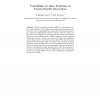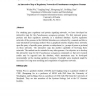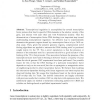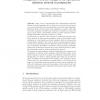102
Voted
RECOMB
2005
Springer
15 years 6 months ago
2005
Springer
Abstract. Peptide recognition modules (PRMs) are specialised compact protein domains that mediate many important protein-protein interactions. They are responsible for the assembly...
111
Voted
RECOMB
2005
Springer
15 years 6 months ago
2005
Springer
Phenotypic differences between closely-related species may arise from differential expression regimes, rather than different gene complements. Knowledge of cellular protein levels ...
96
Voted
RECOMB
2005
Springer
15 years 6 months ago
2005
Springer
For studying gene regulatory and protein signaling networks, we have developed an interactive map for the Pseudomonas aeruginosa genome. We first represent genes, proteins and the...
126
Voted
RECOMB
2005
Springer
16 years 29 days ago
2005
Springer
Background: Most cellular processes are carried out by multi-protein complexes, groups of proteins that bind together to perform a specific task. Some proteins form stable complex...
119
Voted
RECOMB
2005
Springer
16 years 29 days ago
2005
Springer
Abstract. The Pathalyzer is a program for analyzing large-scale signal transduction networks. Reactions and their substrates and products are represented as transitions and places ...
113
click to vote
RECOMB
2005
Springer
16 years 29 days ago
2005
Springer
: A series of genome-scale algorithms and high-performance implementations is described and shown to be useful in the genetic analysis of gene transcription. With them it is possib...
128
click to vote
RECOMB
2005
Springer
16 years 29 days ago
2005
Springer
Protein-protein interaction networks, particularly that of the yeast S. Cerevisiae, have recently been studied extensively. These networks seem to satisfy the small world property ...
136
click to vote
RECOMB
2005
Springer
16 years 29 days ago
2005
Springer
Transcriptional regulation is accomplished by several transcription factor proteins that bind to specific DNA elements in the relative vicinity of the gene, and interact with each ...
108
Voted
RECOMB
2005
Springer
16 years 29 days ago
2005
Springer
Abstract. In order to guarantee that the optimal motif is found, traditional pattern-driven approaches perform an exhaustive search over all candidate motifs of length l. We develo...
119
Voted
RECOMB
2005
Springer
16 years 29 days ago
2005
Springer
Many years of experimental and computational molecular biology of model organisms such as Escherichia coli and Saccharomyces cerevisiae has elucidated the gene regulatory network i...




